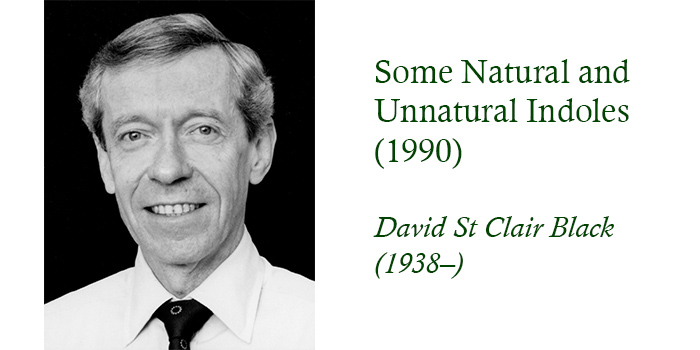27: Some Natural and Unnatural Indoles (1990)
Abstract
Liversidge Research Lecture delivered before the Royal Society of New South Wales, September 5th, 1990, at the University of New South Wales. Reproduced by permission of the Royal Society of New South Wales from J. Proc. Roy. N.S.W., 1990, 123, 1-13.
"New reactions of specially-activated indoles provide methods by which structures related to natural products can be produced. Various 4,6-dimethoxy-substituted indoles exhibit a variety of reactions, predominantly at C7, but others at C2 or C3 instead of C7. The general increase in nucleophilic character of these indoles allows the discovery of reactions which have not been observed for other indoles. These reactions include electrophilic substitution, and addition to aldehydes and ketones. Tri-indolyl macrocycles, pyrrolo[a]indoles, cyclopentano[b]indoles and indolocarbazoles can be produced. Furthermore, new ring-fused indoles can be prepared by intramolecular nitrone 1,3-dipolar cycloaddition reactions between N1 and C2 or N1 and C7. In the latter case, similar structures can be achieved by aldol-type or organometallic reactions. The use of N-aroylindoles enables some known pyrrolophenanthridone alkaloids and some of their unknown analogs to be synthesized effectively."
References
Black, D.St.C., Choy, A., Craig, D.C., Ivory, A.J. and Kumar, N., 1989a. Formation of 7,7'-bi-indolyls by oxidative dimerization of 4,6-dimethoxy-2,3-diphenylindole. Journal of the Chemical Society, Chemical Communications, 111-112.
Black, D.St.C., Craig, D.C. and Kumar, N., 1989b. Synthesis of a new class of indole-containing macrocycles. Journal of the Chemical Society, Chemical Communications, 425-426.
Black, D.St.C., Ivory, A.J., Keller, P.A. and Kumar, N., 1989c. A ready synthesis of 4-oxo-4H-pyrrolo[3,2,1-ij]quinolines. Synthesis, 322-323.
Black, D.St.C., Keller, P.A. and Kumar, N., 1989d. A direct synthesis of pyrrolophenanthridone alkaloids. Tetrahedron Letters, 30, 5807-5808.
Black, D.St.C. and Kumar, N., 1984. A general strategy for the synthesis of 2,2'-, 2,3'-, and 2,7-bi-indolyls. Journal of the Chemical Society, Chemical Communications, 441-442.
Black, D.St.C. and Kumar, N., 1990. Pyrroloquinolines. Organic Preparations and Procedures International, in press.
Black, D.St.C., Kumar, N. and Wong, L.C.H., 1986a. Synthesis of 4,6-dimethoxyindoles. Australian Journal of Chemistry, 39, 15-20.
Black, D.St.C., Kumar, N. and Wong, L.C.H., 1986b. Synthesis of 2-(7-indolyl)-benzimidazoles via 7-formylindoles. Synthesis, 474-476.
Black, D.St.C., Rothnie, N.E. and Wong, L.C.H., 1983. Metal template reactions. XX. Macrocyclic metal complexes derived from 4,6-dimethoxy-3-methylindole-2,7-dicarbaldehyde and some primary diamines with additional donor atoms. Australian Journal of Chemistry, 36, 2407-2412.
Cheng, K.F., Kong, Y.C., and Chan, T.Y., 1985. Biomimetic synthesis of yuehchukene. Journal of the Chemical Society, Chemical Communications, 48-49.
Harrington, P.J. and Hegedus, L.S., 1984. Palladium-catalyzed reactions in the synthesis of 3- and 4-substituted indoles. Approaches to ergot alkaloids. Journal of Organic Chemistry, 49, 2657-2662.
Hayakawa, K., Yasukouchi, T. and Kanematsu, K., 1987. A new approach to pyrrolophenanthridone alkaloids via allene intramolecular cycloaddition: total synthesis of hippadine. Tetrahedron Letters, 28, 5895-5898.
Hegedus, L.S., Allen, G.F., Bozell, J.J. and Waterman, E.L., 1978. Palladium-assisted intramolecular amination of olefins. Synthesis of nitrogen heterocycles. Journal of the American Chemical Society, 100, 5800-5807.
Itahara, T., 1979. Intrarnolecular ring closure of 1-aroylindoles by palladium acetate. Synthesis, 151-152.
Kong, Y.C., Cheng, K.F., Cambie, R.C. and Waterman, P.G., 1985. Yuehchukene : a novel indole alkaloid with anti-implantation activity. Journal of the Chemical Society, Chemical Communications, 47-48.
Llabres, J.M., Viladomat, F., Bastida, J., Codina, C. and Rubiralta, M., 1986. Phenanthridine alkaloids from Narcissus assoanus. Phytochemistry, 25, 2637-2638.
Prabhakar, S., Lobo, A.M. and Marques, M.M., 1987. A new synthesis of the Arnaryllidaceae alkaloid hippadine. Journal of Chemical Research (S), 167.
Siddiqui, M.A. and Snieckus, V., 1990. Concise syntheses of the Amaryllidaceae alkaloids ungerimine and hippadine via the Suzuki aryl-aryl cross coupling reaction. Tetrahedron Letters, 31, 1523-1524.
Tillequin, F., Koch, M., Pousset, J.L. and Cavé, A., 1978. Biomimetic synthesis of borreverine and isoborreverine. Journal of the Chemical Society, Chemical Communications, 826-828.
Wenkert, E., Moeller, P.D.R., Piettre, S.R. and McPhail, A.T., 1988. Yuehchukene analogues. Journal of Organic Chemistry, 53, 3170-3178.

